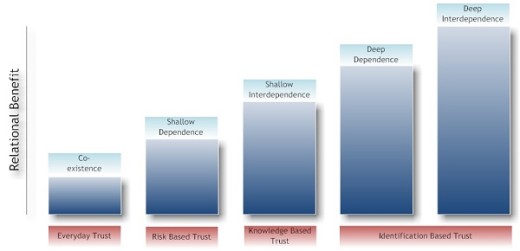Shallow Interdependence – Part 3
In article two we explored and discussed the second level of B2B customer relational interdependence, that of shallow dependence. In article three, we explore ‘shallow interdependence’. This is an aspect of B2B customer management, where most vendors and customers start to develop mutual value through a more structured relationship, having established a trading relationship through shallow dependence.
What do we mean by Shallow interdependence?
|
Element |
What do we mean |
| Shallow Interdependence | Reliance of both the Organisation/Brand/Service and customer mutually on each other within the relationship. |
The relationship starts to develop a more strategic aspect as other elements of the proposition are enabled to release value. A key dynamic /driver within this change is the shift in trust between the vendor and customer. A pattern of transactions may have indicated a willingness from both sides to move beyond risk based trust and into knowledge based trust. In this stage the vendor makes available knowledge that offers the customer increased value opportunities on the understanding that it is mutually value enhancing. In essence the vendor and customer open up and increase their vulnerability through knowledge about each other’s organisations. This increased risk is accepted as the requirement to unlock additional value for both sides e.g. vendor indicates a value upside through logistics configuration and customer reveals internal operations to validate the opportunity and mutual value available.
It is important to hold onto the value of the knowledge exchanged within the relationship. Is it ‘one –off’ or continually updated? Remember, ‘one –off’ knowledge loses its value the moment it’s exchanged. The aim is to ensure it’s the continuous enabler to greater value opportunities. It is worth exploring how you can hold onto this knowledge providing access to it as a condition or result of greater interdependence.
Regular business meetings are used to share insights and knowledge about the market, category, and channels. They are viewed as opportunities to explore value between vendor and customer. The key is to ensure the value can be retained within the relationship for mutual value and not lost to the customer with little vendor advantage.
Increased discovery between the vendor and customer may lead to joint working around mutual value creation. It is important that a structured process is employed to enable both sides to come together in the most efficient and effective way with transparent value streams and outcomes. A jointly agreed phase and gate process is just one way of addressing this area.
At this stage, the relationship can also offer opportunities to develop a greater deal of predictability through the forecasting of demand (which can be made either qualitatively or quantitatively). If pursued in the right way a greater level of predictability within the relationship can build trust and lead to greater interdependency through supply and demand planning. This can lead to efficiency and effectiveness within the supply chain. (More of this within Deep Interdependence)
Consistency: Do you have ’one way’ of working consistently across the organisation? Business to business customers are often multi- layered and multi -divisional. As the vendor penetrates the customer, exploring additional value opportunities it is important a consistent approach is employed. Differences within CM delivery and a disjointed approach could undermine the development of trust within the relationship, as customers struggle to understand which approach is the true one.
Communication & information systems: Do you operate electronic data interchange (EDI), Web portal, shared sites, reporting and reviews? As the relationship enters a more regular trading pattern and the requirement for communication and information exchange increases, it is normal for the joint systems for information/knowledge exchange to develop. These can be seen as further trust builders allowing information and knowledge sharing. If managed proactively they can be effective loyalty builders and initial development of barriers to exit. This area can lead to extensive integrated systems as vendors and customers move towards auto inventory management, auto order acknowledgement, sign-off and reconciliation. (More of this within ‘Deep interdependence)
So, what are the potential downsides?
- The organisation starts to make itself more open through the sharing of knowledge and trusts the customer to approach any value upside in a mutually beneficial way.
- Interdependence initiatives take longer to realise in value terms for both sides and the customer loses interest. The value isn’t evident or delivered within the customer’s time horizon. E.g. a cost saving and efficiency improvement, takes twelve months to realise, yet the customer needed to integrate the solution within six months for the product to hit market opportunity.
- Short term tactical trading issues can impact the relationship development in the early stages and divert the development of more sustainable interdependence.
So, what are the potential upsides?
- The increased access both sides start to develop within each other’s organisation offer more opportunities for both sides to evaluate and develop.
- Improvements in forecasting and accuracy feed through into operational efficiency and effectiveness.
- As trust builds within the relationship the customer becomes more open to new products trials or collaborative work around existing product development
- The increasingly strategic nature of the relationship ensures sufficient understanding exist within the key stakeholders on both sides to withstand tactical trading issues. They also provide the ideal framework for their resolution as and when they occur.
- An environment is created between both vendor and customer that develops increased customer loyalty and at the same time builds barriers to exit.
In article four, we discuss how the customer management relationship can move from Shallow interdependence and into Deep dependence, unless you are prepared and capable of avoiding it. This brings into play our next level of Interdependence ~ Deep Dependence.
|
Element |
What do we mean |
| Deep Dependence | The relationship is determined, influenced and controlled by the core customers. A greater reliance & trust is placed upon the customer for the relationship to remain equitable. |
- Stop hiding behind your computer and get out to see your customers! - March 6, 2024
- B2B Trust Research: What are Boundary Spanners? - January 31, 2024
- A Business to Business Model of Trust - June 27, 2023







